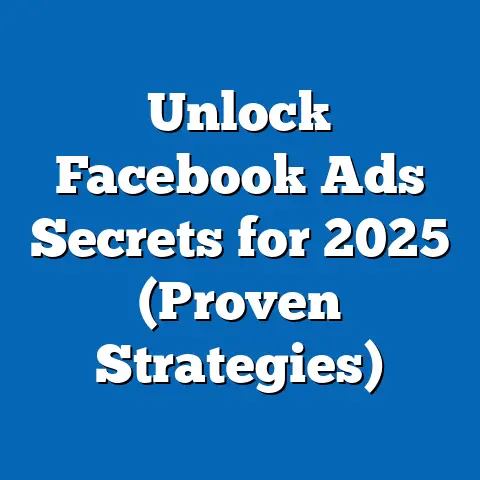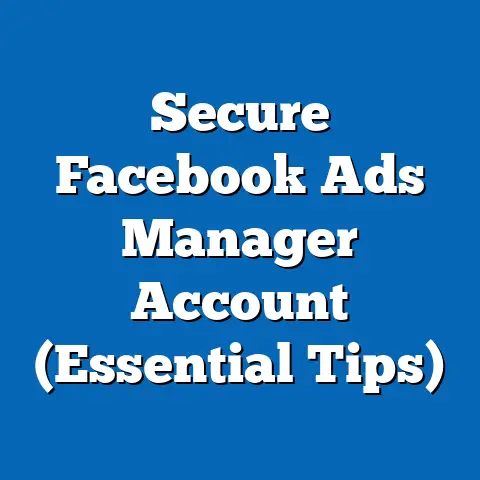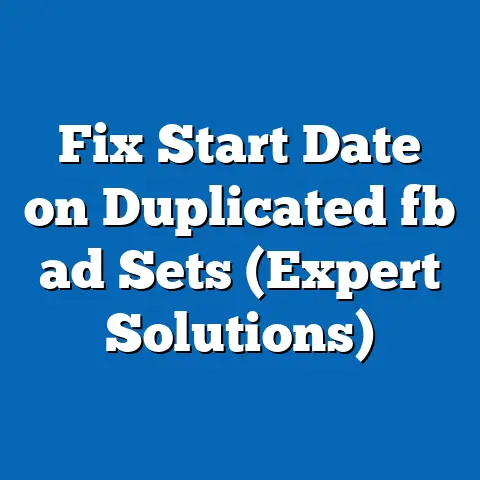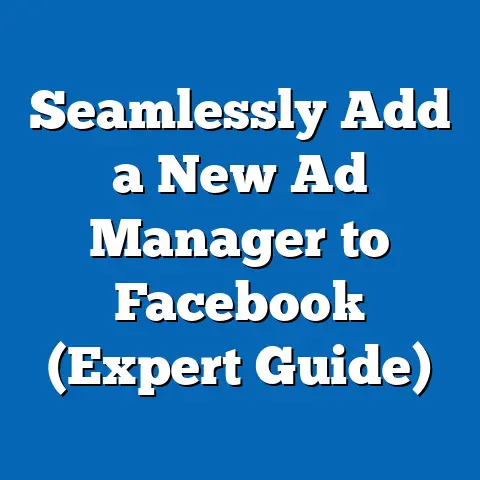Unlock Facebook Ads: Overcoming Publishing Barriers (Expert Tips)
Remember the thrill of launching your first Facebook ad campaign? The excitement of seeing your ideas come to life and reaching a global audience? I certainly do. I remember back when I started, the sheer potential of reaching so many people with targeted messages was intoxicating. Yet, have you ever faced roadblocks that made you question your strategies? I know I have. There were times when I’d pour my heart and soul into an ad, only to have it rejected. Frustrating, right? These publishing barriers are a reality for many advertisers, but trust me, they’re not insurmountable. This guide is designed to help you navigate those hurdles and unlock the true potential of Facebook ads.
Understanding the Landscape of Facebook Ads
Facebook isn’t just a social network anymore; it’s a marketing behemoth. In the current digital era, it’s arguably one of the most significant platforms for businesses looking to connect with their target audience. With billions of active users, Facebook offers unparalleled reach and targeting capabilities. I’ve seen firsthand how businesses, both big and small, have leveraged Facebook ads to drive brand awareness, generate leads, and boost sales.
The evolution of Facebook ads has been remarkable. From simple text-based ads to sophisticated video campaigns, the platform has continually adapted to meet the changing needs of advertisers. The algorithms have become more complex, the targeting options more granular, and the ad formats more diverse.
Staying updated with Facebook’s advertising guidelines and best practices is absolutely crucial. I can’t stress this enough. Facebook’s policies are constantly evolving, and what worked last year might not work today. Ignoring these guidelines can lead to ad disapprovals, account restrictions, or even permanent bans. Trust me, I’ve learned this the hard way!
Takeaway: Facebook ads are a powerful tool, but staying informed about the platform’s ever-changing landscape is key to success.
Common Publishing Barriers
Let’s talk about the roadblocks. Over the years, I’ve identified several common publishing barriers that trip up advertisers. Understanding these challenges is the first step towards overcoming them.
- Ad Disapproval Due to Policy Violations: This is probably the most common headache. Facebook has strict advertising policies that cover everything from prohibited content to misleading claims. I’ve had ads rejected for seemingly minor infractions, like using slightly exaggerated language.
- Technical Issues During Ad Creation: The Ad Manager, while powerful, can be a bit clunky at times. I’ve encountered glitches, bugs, and confusing settings that made the ad creation process a real pain.
- Budget Limitations: Let’s face it, advertising costs money. If your budget is too low, your ads might not reach enough people to make a meaningful impact. I remember one campaign where I tried to stretch a tiny budget way too thin, and the results were predictably disappointing.
- Audience Targeting Challenges: Reaching the right audience is critical. If your targeting is too broad or too narrow, your ads might not resonate with the people you’re trying to reach. I once targeted an audience that was way too generic, and my ad spend was basically wasted on people who had no interest in my product.
Takeaway: Knowing the common publishing barriers allows you to anticipate and proactively address potential issues.
Expert Tip #1: Crafting Compliant Ad Content
Crafting compliant ad content is an art form. It’s about finding the sweet spot between grabbing attention and adhering to Facebook’s often-strict advertising policies. I’ve learned that a proactive approach is key.
- Understand the Policies: Start by thoroughly reviewing Facebook’s advertising policies. I know it’s a long and dry read, but it’s essential. Pay close attention to the sections on prohibited content, personal attributes, and misleading claims.
- Avoid Misleading Claims: This is a big one. Don’t make promises you can’t keep or exaggerate the benefits of your product or service. I once saw an ad that claimed a weight loss supplement could help you “lose 20 pounds in a week.” That’s a blatant violation of Facebook’s policies.
- Use Appropriate Imagery: Your visuals should be relevant, tasteful, and non-offensive. Avoid images that are sexually suggestive, violent, or discriminatory. I’ve seen ads get rejected for using images that were deemed “overly provocative.”
- Be Mindful of Personal Attributes: Don’t target ads based on sensitive personal attributes like race, religion, or sexual orientation. This is a big no-no.
- Review Before Submitting: Before you submit your ad, take a step back and review it carefully. Ask yourself if it complies with all of Facebook’s policies. It’s always a good idea to get a second opinion from a colleague or friend.
Let me give you an example. I once worked on an ad campaign for a local gym. Instead of making broad claims about weight loss, we focused on the community aspect of the gym and highlighted the positive impact it had on people’s lives. We used images of happy members working out together and testimonials from people who had achieved their fitness goals. The ad was compliant, engaging, and ultimately successful.
Takeaway: Compliant ad content is not just about avoiding rejection; it’s about building trust with your audience and creating a positive brand image.
Expert Tip #2: Navigating the Ad Manager
The Facebook Ad Manager is a powerful tool, but it can also be intimidating, especially for beginners. I remember feeling completely overwhelmed when I first started using it. But with a little practice and guidance, you can master it.
- Familiarize Yourself with the Interface: Take some time to explore the Ad Manager and familiarize yourself with the different sections and features. Pay attention to the campaign structure, ad sets, and individual ads.
- Use the Help Center: Facebook’s Help Center is a treasure trove of information. If you’re stuck on something, chances are you can find the answer there.
- Join Community Forums: There are tons of Facebook advertising communities online where you can ask questions, share tips, and learn from other advertisers.
- Troubleshoot Common Technical Issues: Here are a few common technical issues and how to fix them:
- Ad Not Showing: Make sure your ad is approved, your budget is sufficient, and your targeting is correct.
- Website Pixel Not Firing: Double-check that your pixel is installed correctly and that it’s firing on the right pages.
- Conversion Tracking Issues: Ensure that your conversion events are set up properly and that they’re tracking the right actions.
- Ad Not Showing: Make sure your ad is approved, your budget is sufficient, and your targeting is correct.
- Website Pixel Not Firing: Double-check that your pixel is installed correctly and that it’s firing on the right pages.
- Conversion Tracking Issues: Ensure that your conversion events are set up properly and that they’re tracking the right actions.
I once spent hours trying to figure out why my website pixel wasn’t firing. It turned out I had accidentally copied and pasted the pixel code incorrectly. A simple mistake, but it cost me a lot of time and frustration.
Takeaway: Mastering the Ad Manager is essential for creating, managing, and optimizing your Facebook ad campaigns.
Expert Tip #3: Setting Realistic Budgets and Bids
Setting realistic budgets and bids is crucial for maximizing your ROI. I’ve seen too many advertisers waste money by setting unrealistic budgets or choosing the wrong bidding strategies.
- Determine Your Campaign Goals: What are you trying to achieve with your Facebook ads? Are you trying to drive brand awareness, generate leads, or boost sales? Your campaign goals will influence your budget and bidding strategy.
- Research Industry Benchmarks: Take some time to research industry benchmarks for Facebook advertising costs. This will give you a sense of how much you need to spend to achieve your goals.
- Choose the Right Bidding Strategy: Facebook offers several different bidding strategies, including:
- Lowest Cost: Facebook will try to get you the most results for your budget.
- Cost Cap: You set a target cost per result, and Facebook will try to stay within that limit.
- Target Cost: You set a target cost per result, and Facebook will try to achieve that cost.
- Value Optimization: Facebook will try to find the people who are most likely to make a purchase.
- Lowest Cost: Facebook will try to get you the most results for your budget.
- Cost Cap: You set a target cost per result, and Facebook will try to stay within that limit.
- Target Cost: You set a target cost per result, and Facebook will try to achieve that cost.
- Value Optimization: Facebook will try to find the people who are most likely to make a purchase.
The best bidding strategy for you will depend on your campaign goals and budget.
- Monitor Your ROI: Keep a close eye on your ROI and adjust your budget and bidding strategy accordingly. If you’re not getting the results you want, don’t be afraid to experiment.
I once worked on a campaign where we started with a low budget and a “lowest cost” bidding strategy. As we gathered data and optimized our targeting, we gradually increased our budget and switched to a “cost cap” bidding strategy. This allowed us to achieve our goals while staying within our budget.
Takeaway: Setting realistic budgets and bids is a balancing act. It’s about finding the right combination of spending and strategy to achieve your campaign goals.
Expert Tip #4: Targeting the Right Audience
Targeting the right audience is the key to success with Facebook ads. I’ve seen ads that were brilliantly creative but completely ineffective because they were shown to the wrong people.
- Use Facebook’s Audience Insights Tool: This tool allows you to learn more about your target audience, including their demographics, interests, and behaviors.
- Create Custom Audiences: You can create custom audiences based on your existing customer data, such as email lists or website visitors.
- Create Lookalike Audiences: You can create lookalike audiences based on your custom audiences. This allows you to reach people who are similar to your existing customers.
- A/B Test Different Audience Segments: Don’t be afraid to experiment with different audience segments. A/B testing can help you identify the most responsive audiences for your ads.
I once worked on a campaign for a local restaurant. We started by targeting a broad audience of people who lived in the area and were interested in food. But we quickly realized that this audience was too broad. We then created a custom audience based on people who had visited the restaurant’s website and a lookalike audience based on that custom audience. This allowed us to reach a much more targeted audience and significantly improve our results.
Takeaway: Targeted advertising is not just about reaching more people; it’s about reaching the right people.
Expert Tip #5: Leveraging Analytics for Continuous Improvement
Facebook ad analytics are a goldmine of information. I’ve learned that the key to success is not just collecting data but also interpreting it and using it to make informed decisions.
- Track Key Metrics: Pay attention to key metrics like reach, impressions, clicks, conversions, and cost per result.
- Analyze Your Data: Look for patterns and trends in your data. What ads are performing well? What audiences are responding best? What bidding strategies are most effective?
- Make Data-Driven Decisions: Use your data to refine your targeting, optimize your ad creative, and adjust your bidding strategy.
- Continuously Test and Optimize: Facebook advertising is an ongoing process of testing and optimization. Don’t be afraid to experiment with different approaches and see what works best for you.
I once worked on a campaign where we noticed that our ads were performing much better on mobile devices than on desktop computers. We then adjusted our targeting to focus on mobile users and saw a significant improvement in our results.
Takeaway: Data-driven decision-making is the cornerstone of successful Facebook advertising.
Conclusion
Publishing barriers in Facebook ads can be frustrating, but they’re not insurmountable. I’ve shared some expert tips that I’ve learned over the years, and I encourage you to apply them to your own advertising efforts. Craft compliant ad content, master the Ad Manager, set realistic budgets and bids, target the right audience, and leverage analytics for continuous improvement.
Overcoming these barriers can lead to successful and impactful ad campaigns. It’s about being proactive, staying informed, and never giving up. So, go out there, create amazing ads, and reach your target audience. The possibilities are endless!





